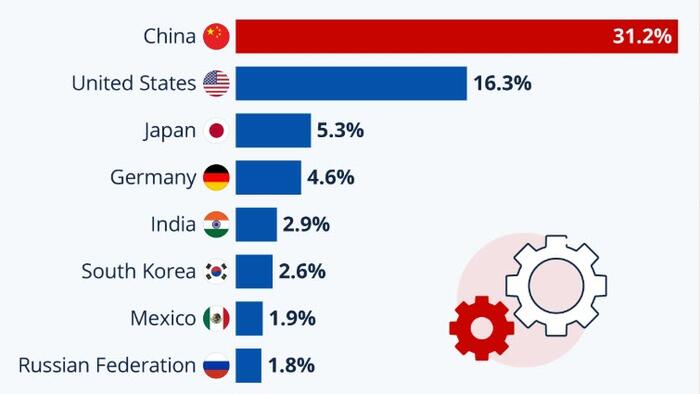In 2022, China emerged as the foremost player in global manufacturing, contributing a remarkable 31 percent of the world’s total manufacturing output, as highlighted by data from the United Nations Statistics Division. This figure represents a significant lead over the United States, which ranked second with a manufacturing output share approximately 15 percentage points lower. Historically, the U.S. held the title of the largest manufacturing sector until China surpassed it in 2010. This shift marks a critical transition in the global economic landscape, illustrating how much the center of manufacturing power has shifted towards China.
The value added by China’s manufacturing sector exceeded $5 trillion in 2022, signifying that almost 30 percent of the nation’s economic output stemmed from manufacturing activities. This substantial contribution underscores China’s integral role in the global supply chain, affecting everything from raw materials to finished products. Concurrently, the role of manufacturing in the U.S. economy has diminished significantly; by the same year, it represented just over 10 percent of the nation’s gross domestic product (GDP). This shift reflects broader trends in both economies, with China consolidating its position and the U.S. increasingly relying on services and technology rather than traditional manufacturing.
China’s dominance in the manufacturing sector is underscored by its output, which, notably, matches the combined value added by the next seven largest manufacturing countries worldwide. This staggering statistic emphasizes how concentrated manufacturing capabilities are in China relative to the global market. Countries such as Japan, Germany, India, South Korea, Italy, Brazil, and the United Kingdom follow China, but their combined manufacturing contribution pales in comparison to China’s colossal output. This stark contrast reveals not only the scale of China’s manufacturing capabilities but also the competitive challenges faced by other nations striving to bolster their manufacturing sectors.
The implications of China’s manufacturing leadership extend beyond mere statistics; they influence global trade, employment, and technological development. As the largest manufacturer, China has considerable leverage over international supply chains, often dictating terms and availability of goods worldwide. This dominance can create dependencies for countries reliant on Chinese manufacturing, potentially leading to vulnerabilities in the global market during periods of disruption. Furthermore, the focus on manufacturing has catalyzed advancements in technology and productivity within China, as the country continues to invest in modernizing its industrial base.
In contrast, the U.S. has experienced a gradual decline in its manufacturing base, which has raised concerns about the sustainability of domestic production and its associated jobs. As manufacturing has become less central to the U.S. economy, policymakers face the challenge of adapting to this new landscape while fostering innovation and competitiveness. There are ongoing discussions about reshoring certain manufacturing activities to regain some level of self-sufficiency, particularly in critical sectors such as semiconductors and pharmaceuticals. However, the transition requires balancing the costs and benefits of revitalizing U.S. manufacturing while navigating the entrenched advantages enjoyed by China and other competing countries.
In conclusion, the data reinforces the narrative of a significant global reshuffling where China stands at the forefront of manufacturing. The economic ramifications of this shift are profound, affecting global trade dynamics, labor markets, and technological innovation. As nations respond to China’s formidable position, there will be a greater emphasis on revitalizing domestic industries and exploring new strategies to mitigate dependency on Chinese manufacturing. The landscape of global manufacturing is likely to evolve as countries adapt to these developments, ensuring that manufacturing remains a priority in national economic policy discussions moving forward.

